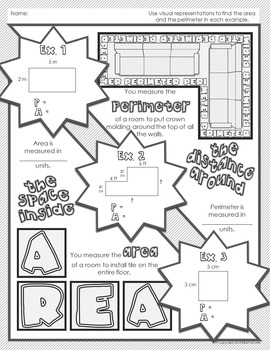Area & Perimeter Doodle Notes
Math Giraffe
25.1k Followers
Resource Type
Standards
CCSS3.MD.C.7
CCSS3.MD.C.7b
CCSS3.MD.C.7d
Formats Included
- PDF
Pages
1 plus answer key & info
Math Giraffe
25.1k Followers
What educators are saying
I love using Doodle notes and used this on the second day of area and perimeter rather than starting with notes. My students keep this page in their binders as a reference.
This was a great resource for activating prior knowledge of area and perimeter before diving into our 6th grade unit on area of polygons. It is very accessible for the students, and the graphics are fun. My students enjoyed this quick refresher.
Description
Basic Introduction to Perimeter and Area: "doodle notes" -
When students color or doodle in math class, it activates both hemispheres of the brain at the same time. There are proven benefits of this cross-lateral brain activity:
- new learning
- relaxation (less math anxiety)
- visual connections
- better memory & retention of the content!
Students fill in the sheets, complete a few examples, and color, doodle or embellish. Then, they can use it as a study guide later on.
Content includes:
- meaning of area and perimeter
- examples finding area and perimeter with figures made of only rectangles
- analogies for remembering which is which (with visual representation)
** Two options are included - The pages are identical except for example 2. Choose between a basic rectangle (great for grades 3-4) and a compound figure made of 2 rectangles (great for grades 5-6).
Check out the preview for more detail about this item and the research behind it.
You might also like:
The Coordinate Plane: A Spiral Studies Mini-Unit
Prime Factorization GridWords
Coordinate PLANES: Paper Airplanes from Plotting Points
When students color or doodle in math class, it activates both hemispheres of the brain at the same time. There are proven benefits of this cross-lateral brain activity:
- new learning
- relaxation (less math anxiety)
- visual connections
- better memory & retention of the content!
Students fill in the sheets, complete a few examples, and color, doodle or embellish. Then, they can use it as a study guide later on.
Content includes:
- meaning of area and perimeter
- examples finding area and perimeter with figures made of only rectangles
- analogies for remembering which is which (with visual representation)
** Two options are included - The pages are identical except for example 2. Choose between a basic rectangle (great for grades 3-4) and a compound figure made of 2 rectangles (great for grades 5-6).
Check out the preview for more detail about this item and the research behind it.
You might also like:
The Coordinate Plane: A Spiral Studies Mini-Unit
Prime Factorization GridWords
Coordinate PLANES: Paper Airplanes from Plotting Points
Total Pages
1 plus answer key & info
Answer Key
Included
Teaching Duration
45 minutes
Report this resource to TPT
Reported resources will be reviewed by our team. Report this resource to let us know if this resource violates TPT’s content guidelines.
Standards
to see state-specific standards (only available in the US).
CCSS3.MD.C.7
Relate area to the operations of multiplication and addition.
CCSS3.MD.C.7b
Multiply side lengths to find areas of rectangles with whole-number side lengths in the context of solving real world and mathematical problems, and represent whole-number products as rectangular areas in mathematical reasoning.
CCSS3.MD.C.7d
Recognize area as additive. Find areas of rectilinear figures by decomposing them into non-overlapping rectangles and adding the areas of the non-overlapping parts, applying this technique to solve real world problems.




